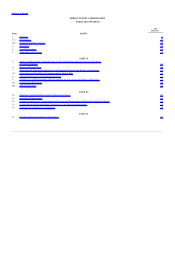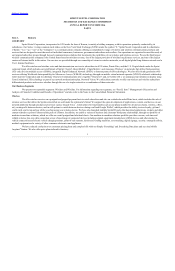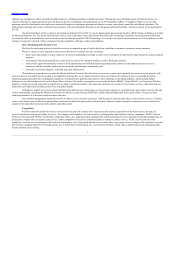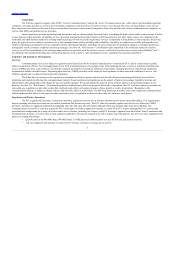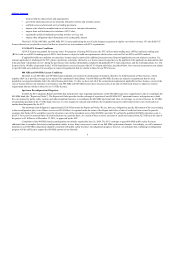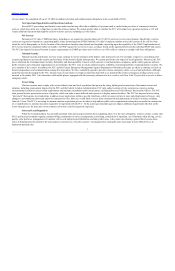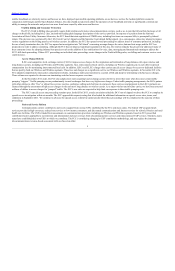Sprint - Nextel 2011 Annual Report Download - page 7
Download and view the complete annual report
Please find page 7 of the 2011 Sprint - Nextel annual report below. You can navigate through the pages in the report by either clicking on the pages listed below, or by using the keyword search tool below to find specific information within the annual report.
Table of Contents
Competition
Our Wireline segment competes with AT&T, Verizon Communications, CenturyLink, Level 3 Communications, Inc., other major local incumbent operating
companies, and cable operators as well as a host of smaller competitors in the provision of wireline services. Over the past few years, our long distance voice services
have experienced an industry-wide trend of lower revenue from lower prices and increased competition from other wireline and wireless communications companies, as
well as cable MSOs and Internet service providers.
Some competitors are targeting the high-end data market and are offering deeply discounted rates in exchange for high-volume traffic as they attempt to utilize
excess capacity in their networks. In addition, we face increasing competition from other wireless and IP-based service providers. Many carriers are competing in the
residential and small business markets by offering bundled packages of both local and long distance services. Competition in long distance is based on price and pricing
plans, the types of services offered, customer service, and communications quality, reliability and availability. Our ability to compete successfully will depend on our
ability to anticipate and respond to various competitive factors affecting the industry, including new services that may be introduced, changes in consumer preferences,
demographic trends, economic conditions and pricing strategies. See Item 1A, “Risk Factors—Consolidation and competition in the wholesale market for wireline
services, as well as consolidation of our roaming partners and access providers used for wireless services, could adversely affect our revenues and profitability” and “—
The blurring of the traditional dividing lines among long distance, local, wireless, video and Internet services contributes to increased competition.”
Legislative and Regulatory Developments
Overview
Communications services are subject to regulation at the federal level by the Federal Communications Commission (FCC) and in certain states by public
utilities commissions (PUCs). The Communications Act of 1934 (Communications Act) preempts states from regulating the rates or entry of commercial mobile radio
service (CMRS) providers, such as those in our Wireless segment, and imposes licensing and technical requirements, including provisions related to the acquisition,
assignment or transfer of radio licenses. Depending upon state law, CMRS providers can be subject to state regulation of other terms and conditions of service. Our
Wireline segment also is subject to federal and state regulation.
The following is a summary of the regulatory environment in which we operate and does not describe all present and proposed federal, state and local
legislation and regulations affecting the communications industry. Some legislation and regulations are the subject of judicial proceedings, legislative hearings and
administrative proceedings that could change the way our industry operates. We cannot predict the outcome of any of these matters or their potential impact on our
business. See Item 1A, “Risk Factors—Government regulation could adversely affect our prospects and results of operations; the FCC and state regulatory commissions
may adopt new regulations or take other actions that could adversely affect our business prospects, future growth or results of operations.” Regulation in the
communications industry is subject to change, which could adversely affect us in the future. The following discussion describes some of the significant communications-
related regulations that affect us, but numerous other substantive areas of regulation not discussed here may also influence our business.
R
e
g
ulation and Wireless Operations
The FCC regulates the licensing, construction, operation, acquisition and sale of our wireless operations and wireless spectrum holdings. FCC requirements
impose operating and other restrictions on our wireless operations that increase our costs. The FCC does not currently regulate rates for services offered by CMRS
providers, and states are legally preempted from regulating such rates and entry into any market, although states may regulate other terms and conditions. The
Communications Act and FCC rules also require the FCC's prior approval of the assignment or transfer of control of an FCC license, although the FCC's rules permit
spectrum lease arrangements for a range of wireless radio service licenses, including our licenses, with FCC oversight. Approval from the Federal Trade Commission and
the Department of Justice, as well as state or local regulatory authorities, also may be required if we sell or acquire spectrum interests. The FCC sets rules, regulations and
policies to, among other things:
5
• grant licenses in the 800 MHz band, 900 MHz band, 1.9 GHz personal communications services (PCS) band, and license renewals;
• rule on assignments and transfers of control of FCC licenses, and leases covering our use of FCC


